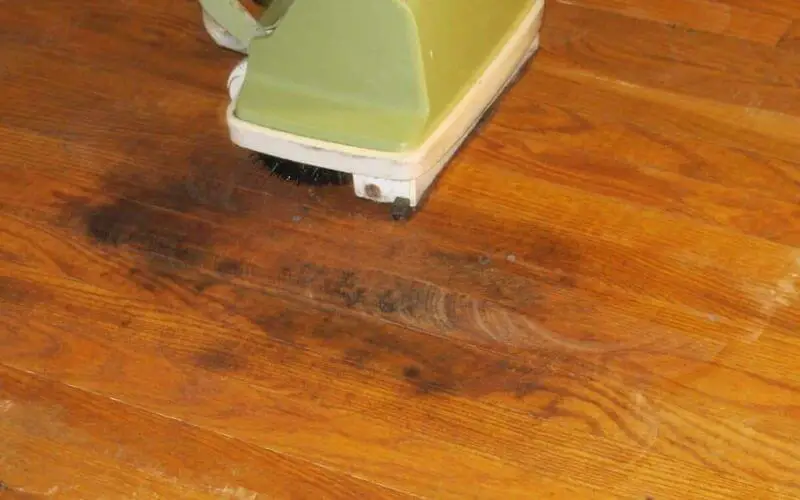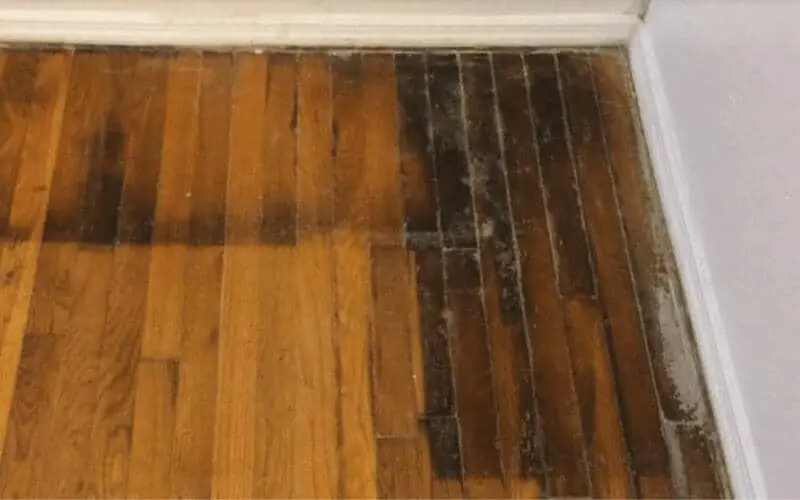Why is my engineered wood floor turning black? Let’s find out. If you spot your engineered wood floor turning black, it is usually a cause for concern. Dark marks and spots not only ruin your home’s interior aesthetics but could be an indicator of greater damage.
Engineered wood floors utilize multi-ply core construction, and their surface layer is made of real wood. This makes engineered wood floors prone to water damage, just like natural hardwood floorboards.
An engineered wood floor can develop discoloration due to sap stains, iron stains, tannic acid discoloration, chemical stains, and moisture.
You can eliminate dark spots and discoloration from your floor using any of the following methods; keep in mind that the cause of the discoloration determines the right method of removal.
Read: How to remove black spot on hardwood floor
How To Remove Black Stains On Engineered Wood Floor
Table of Contents
Removing Discoloration Caused By Water Damage
Black stain on engineered wood floor is commonly caused by prolonged water damage to the floorboards. You are going to need effective removal methods to get rid of black stains on engineered wood floor stains caused by moisture damage:
Lighten the Stain Using Bleach
For black water stains, sanding alone may not be effective. First, lighten the stain by applying bleach to it. The bleach causes the wood grain to rise to the surface and also eliminates mold growth caused by water exposure.
Mix one part chlorine bleach with eight parts water and add a cupful of baking soda. Pour the solution into a spray bottle and apply it to affected areas of the floor.
Let the solution sit for about five minutes before using a dry piece of cloth or a paper towel to wipe off excess bleach.
Read: how to whitewash laminate floor
Lightly Sand the Floor
When the black spots become lighter after bleaching, you can lightly sand them down, but make sure your engineered wood floor is sandable before refinishing them.
If your floor can be sanded, use only fine-grit sandpaper (100-120 grit), so you do not remove the lightened top section of the floor. You can apply a matching stain to the sanded areas so that they blend in with the rest of the floor.
Read: How to sand hardwood floors
Removing Black Spots Caused By Mold
If the dark stains on your engineered wood flooring are caused by mold growth, you can tell by the odor. Mold spores carry an earthy, musty smell and can trigger various health issues; this is why it is very crucial to deal with mold growth as soon as it’s discovered. Here’s a detailed procedure on how to do so:
Start by ripping up the affected floorboard to access the subfloor, as it’s highly likely that the problem started out from or has spread to the subfloor.
Remove the baseboard trim and transitional trims before taking out the planks one by one. This is a labor-intensive job, especially if the floor is attached to the subfloor with nails. But if you want to completely get rid of the mold problem, it’s a step you shouldn’t skip.
When the floorboard is removed, you can easily identify mold-infested sections. You can eliminate mold growth with vinegar but first, put on a pair of hand gloves to avoid prolonged exposure to the natural acid which can trigger skin irritation.
Add a cupful of distilled white vinegar and a gallon of water in a mop bucket and stir to combine the mixture.
Dip a mop into the vinegar mixture and lightly wring the mop to remove excess water, so you don’t create the same moisture problem that led to mold growth in the first place, then mop the affected areas of the subfloor thoroughly.
Then allow the vinegar to sit for about ten minutes to absorb the mold spores before rinsing the floor with clean water.
Dry up the entire subfloor with a dry mop, and once it is fully dry, you can begin reinstalling the removed floor planks and trimming.
You will need to replace planks badly affected with mold with new ones. Or you can sand down the affected planks and remove stained areas before reapplying the original finish and reinstalling. A mixture of baking soda and vinegar can also be used to kill the mold growth on the affected planks before reinstallation.
Read: How to get rid of spot on hardwood floor
Removing Black Spots Caused By Pet Urine
If the discoloration on your engineered wood floor is a result of pet’s urine. Here’s how to get rid of the staining:
Apply a few drops of hydrogen peroxide solution over the black spots, and cover the area with a piece of cloth saturated with hydrogen peroxide as well and allow it to sit on the stain for a while.
Next, apply a poultice and lay cling film over the affected area while it is still covered with the soaked clothing. Allow the poultice to sit in place for up to half a day, so all the pet urine is pulled out of the hardwood.
After 12 hours, remove the poultice and clean the area using a solution of one part white vinegar and one part water.
Vinegar neutralizes the ammonia in the urine and gets rid of any lingering odors as well. Allow the flooring to dry out completely afterward.
Once the floor is dry, inspect it to see if any trace of pet urine stains are left. If any, you can remove it by lightly sanding the area before finishing it with a matching stain, so it blends with the rest of the floor.
Read: How to remove black urine stain from hardwood floor
Conclusion
Engineered wood floor turning black is caused by a host of different reasons, and you need to identify the cause of discoloration so you can determine the right removal method.
Back to our question again, Why is My Engineered Wood Floor Turning Black? Mold, water damage, and pet urine are some of the most common reasons engineered wood turns black and should be handled accordingly using the methods mentioned above.

